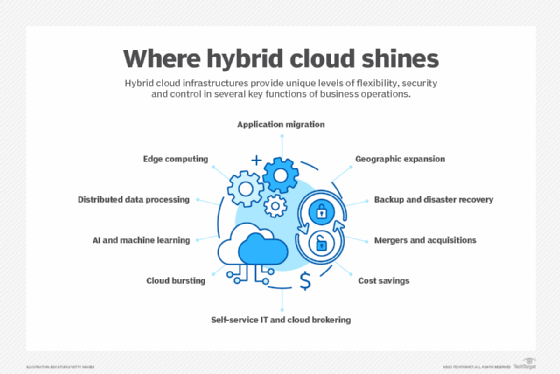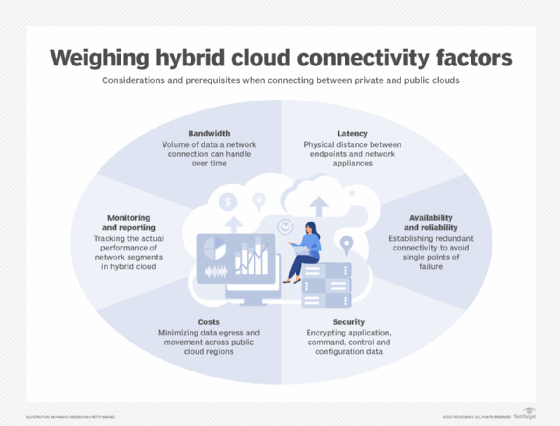7 keys to an effective hybrid cloud migration strategy
Cloud readiness, storage costs, network lag and metrics can make or break the choice to move data, applications and workloads to today's more complex hybrid cloud environment.
Not very long ago, a hybrid cloud migration strategy amounted to a business extending its internal workloads into an environment it doesn't own. Performance and features that once lived in the company's IT environment became partly dependent on a service provider's environment. Back then, a hybrid cloud strategy was relatively simple -- a combination of on-site resources and some type of cloud model to achieve a company's business goals.
Today, a hybrid cloud strategy is intertwined with multi-clouds and vendors that only provide cloud offerings. As a result, several more factors now influence and drive a company's decision about where its data, applications and workloads should reside. Businesses are opting for a hybrid cloud environment due to its promise of AI integration, automation, mobility, portability, flexibility, security and cost savings. However, a hybrid cloud architecture now comes with greater complexity. Implementing and maintaining it requires several key considerations.
1. Determine if an app or service is hybrid cloud-ready
With hybrid cloud strategies, an application must function in an on-premises environment and with resources rented from a service provider such as Amazon Web Services, Microsoft Azure or Google Cloud. An often overlooked but necessary first step is determining whether the application is suitable for a hybrid model.
Check with the application vendor to see what the roadmap is going forward. Don't put a lot of effort into moving an end-of-life, locally installed application to a public cloud service only. Just because a vendor says the application can run in a cloud doesn't mean it's hybrid cloud-ready. It's less complicated to host the application in one environment than to bridge two environments.
A legacy application not ready for hybrid cloud migration can still be successfully adapted if planned properly -- without resembling a Frankenstein concoction. Ideally, pieces of the application that can exist behind load balancers can move to the cloud. Examine application tracking to view traffic communications to get a sense of how much data is shared and how potential lag time might affect application performance. Also, pay attention to licensing models and authorized vendor support platforms that could be violated when moving legacy applications to the cloud.

2. Shift the right pieces of an application
Many applications consist of multiple parts, so determine what can be moved rapidly and cost-effectively to the cloud. An application might be ready for a hybrid model if, for example, additional frameworks or excessive storage needs are required to support it.
Carefully consider on-demand or cloud-bursting capabilities. Also, consider automation as a way to spin workloads up and down quickly and avoid excess costs for housing dormant workloads. Workloads that require excessive customization or large amounts of data storage or compute resources might not be a good fit for a hybrid cloud migration strategy, especially if cost savings is a major goal of cloud adoption.
Automation helps create workloads and eliminate manual effort. Even so, complete and ready-to-go resources don't appear instantly; they take seconds or hours to build. A slow-building workload can be costly because the cloud provider bills for setup time before the workload even runs. Autoscaling can save time and cost.
3. Don't overlook storage
Size is a key consideration in hybrid cloud migration strategies. Cloud storage service costs to house applications grow slowly, so they can easily go unnoticed. They may not break the bank initially, but they can accumulate steadily over time. Combine that with dead or unused data sitting in the cloud, and the monthly cloud storage bill might be prohibitive.
Consider cloud storage tiers for high-speed archiving and lower data stores. Examine the application stack to determine the most cost-effective storage approach for each layer. It's a potentially complex process that's best done early rather than later as the application grows.
4. Check the network
Moving part of a workload to the cloud might introduce lag between the data center and cloud provider, which can affect application performance and customer experiences. An organization's internet service is the lifeline that keeps applications running properly. Network lag or outages between components of multipart applications must be located and rectified using disaster recovery methods, multi-cloud options and redundant on-premises internet connections.

5. Track the metrics
The success of a hybrid cloud migration strategy is best revealed through metrics. Performance statistics and response times are valuable, but they mean little if a hybrid approach costs three to four times that of an on-premises setup.
Examine applications and data from a variety of perspectives -- from performance data to customer engagement to help desk responses. A shift to hybrid cloud, for example, might be more expensive compared to staying on premises, but if help desk calls are reduced by 30%, the overall cost-benefit analysis for hybrid cloud might be favorable.
The challenge is to compare and correlate data points that come from different sources. But the metrics can pay big dividends in determining where to adjust workloads in a hybrid environment and update specific business objectives.
6. Application stack mapping
As data and applications move between on-premises and different cloud environments, be sure the staff knows where everything lives. A user, for instance, might not be able to gain access to an application moved to the cloud because authentication is still on premises. A detailed map of where application pieces reside not only showcases complexity, but also makes building a disaster recovery plan much easier.
7. Move at your own pace
With increased hybrid cloud activity comes many additional services and features offered by cloud providers. It's easy to be distracted by the shiny new features and forget the business goals in adopting hybrid cloud. When considering a hybrid cloud architecture, remember to do a total application rewrite.
Brian Kirsch, an IT architect and Milwaukee Area Technical College instructor, has been in IT for more than 20 years, holds multiple certifications and sits on the VMUG board of directors.







